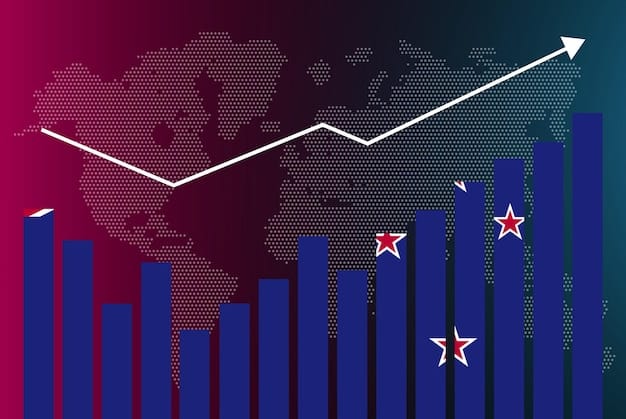How 2.5% GDP Growth in 2025 Will Shape Your Investments

The projected 2.5% GDP growth in 2025 is expected to influence investment strategies across various sectors, potentially leading to increased corporate earnings, higher interest rates, and shifts in market valuations, requiring investors to reassess their portfolios.
The U.S. economy is projected to grow by 2.5% in 2025, a figure that carries significant implications for investors. Understanding how will the projected 2.5% GDP growth in 2025 impact your investments is crucial for making informed decisions and optimizing your portfolio for the coming year. This article will delve into the various ways this growth could affect different sectors and asset classes.
Understanding GDP Growth and Its Significance
Gross Domestic Product (GDP) is a comprehensive measure of a country’s economic activity. A projected GDP growth of 2.5% for 2025 indicates a moderate expansion, influencing various aspects of the financial landscape and investment opportunities. Understanding the basics of GDP and its impact is key to navigating the investment world.
What is GDP?
GDP represents the total monetary or market value of all finished goods and services produced within a country’s borders in a specific time period. It’s a broad measurement of a nation’s overall economic activity.
Why is GDP Growth Important?
GDP growth is often used as an indicator of the economic health of a country. Positive growth typically suggests increasing business activity, job creation, and consumer spending.
Here are some key reasons why GDP growth matters for investors:
- Increased corporate earnings: A growing economy often translates to higher profits for companies, which can boost stock prices.
- Higher interest rates: Strong GDP growth can lead to inflationary pressures, prompting central banks to raise interest rates.
- Market sentiment: Positive GDP figures usually improve investor confidence, driving market rallies.
Understanding these points helps investors appreciate the potential impacts of a 2.5% GDP growth on their investment strategies.

Impact on Different Investment Sectors
A 2.5% GDP growth in 2025 is not a uniform catalyst; its effects will vary across different sectors. Certain industries are more sensitive to economic fluctuations, and investors need to be aware of these nuances to make informed decisions.
Technology Sector
The technology sector often thrives during economic expansions. Increased business investment and consumer spending on tech products and services can drive revenue growth for tech companies.
Consumer Discretionary Sector
This sector, which includes retail, entertainment, and hospitality, tends to benefit from higher consumer confidence and spending during periods of economic growth. People are more likely to spend on non-essential items and experiences when they feel financially secure.
Key considerations for investors regarding sector-specific impacts:
- Healthcare: Generally less sensitive to economic cycles as healthcare needs remain relatively constant.
- Energy: Can benefit from increased demand due to higher industrial production and transportation.
- Financials: May see increased lending activity and investment banking revenue.
Investors should carefully analyze how the projected GDP growth is likely to impact the specific sectors in their portfolios.
Interest Rate Considerations
GDP growth often influences monetary policy, particularly interest rates. Understanding the relationship between GDP growth and interest rates is vital for investors, as interest rate changes can significantly affect investment returns.
The Federal Reserve’s Role
The Federal Reserve (also known as The Fed), aims to maintain price stability and full employment. The Fed closely monitors GDP growth and adjusts interest rates accordingly to manage inflation and stimulate or cool down the economy.
Impact of Higher Interest Rates
If the 2.5% GDP growth leads to rising inflation, the Federal Reserve might raise interest rates to curb price increases. Higher interest rates can have several effects:
Navigating the interest rate environment requires careful consideration and strategic adjustments to investment portfolios.
Here are some potential consequences of rising interest rates:
- Bond prices may fall: As interest rates rise, newly issued bonds offer higher yields, making existing bonds with lower yields less attractive.
- Increased borrowing costs: Higher rates can increase the cost of borrowing for businesses and consumers, potentially slowing economic growth.
- Impact on housing market: Higher mortgage rates can cool down the housing market by reducing demand.

Inflation and Investment Strategies
Inflation is a critical factor to consider when assessing the impact of GDP growth on investments, especially with a projected 2.5% GDP growth in 2025. Rising prices can erode the real value of investment returns, making it essential to adopt strategies that can outpace inflation.
Inflation’s Impact on Investments
Inflation reduces the purchasing power of returns and can negatively impact various asset classes. Investors must account for inflation to preserve the real value of their portfolios.
Strategies to Combat Inflation
Several investment strategies can help mitigate the effects of inflation:
Understanding and implementing these strategies can help safeguard investment portfolios against the adverse effects of inflation.
Consider these investment strategies to mitigate inflation:
- Investing in commodities: Commodities like gold and oil often act as inflation hedges.
- Real Estate: Real estate tends to appreciate during inflationary periods as property values and rental income rise.
- Inflation-Indexed Securities: Treasury Inflation-Protected Securities (TIPS) are designed to protect investors from inflation.
Risk Management in a Growing Economy
While a 2.5% GDP growth indicates positive economic momentum, it doesn’t eliminate the need for effective risk management. A growing economy can also present unique challenges and potential pitfalls that investors should be prepared to navigate.
Identifying Potential Risks
Even in a growing economy, risks such as market volatility, geopolitical events, and unexpected economic shocks can impact investment portfolios. Identifying these risks is the first step in effective risk management.
Diversification Strategies
Diversification remains a cornerstone of risk management. Spreading investments across different asset classes, sectors, and geographies can help reduce the impact of any single investment performing poorly.
Diversification is a fundamental aspect.
Here are some risk mitigation best practices that investors should keep in mind:
- Regular Portfolio Reviews: Regularly assess the performance of your investments and make adjustments as needed.
- Emergency Fund: Maintain an emergency fund to cover unexpected expenses and avoid selling investments during downturns.
- Professional Advice: Consult with a financial advisor to develop a risk management strategy tailored to your specific needs and goals.
Adjusting Your Investment Portfolio for 2025
Given the projected 2.5% GDP growth in 2025, investors should consider making strategic adjustments to their portfolios to capitalize on potential opportunities and mitigate risks. These adjustments may involve rebalancing asset allocations, exploring new investment options, and refining overall investment strategies.
Rebalancing Asset Allocations
Rebalancing involves adjusting the proportion of different asset classes in your portfolio to maintain your desired risk level and investment objectives. Investors should consider rebalancing their portfolios annually or as needed to align with their long-term goals.
Exploring New Investment Options
A growing economy can create new investment opportunities in emerging sectors and asset classes. Investors should research and consider adding these new options to their portfolios to enhance diversification and potentially increase returns.
As you plan your investment portfolio for 2025:
- Stay Informed: Keep abreast of economic developments, market trends, and investment news.
- Seek Professional Guidance: Work with a qualified financial advisor to develop a personalized investment plan.
- Be Patient: Investing is a long-term endeavor, and it’s important to remain patient and disciplined even during market fluctuations.
| Key Point | Brief Description |
|---|---|
| 📈 GDP Growth Impact | 2.5% GDP growth in 2025 influences sectors differently, affecting corporate earnings. |
| 💰 Interest Rate Hikes | The Federal Reserve might raise interest rates to control inflation, impacting bond prices. |
| 🛡️ Inflation Strategies | Invest in commodities, real estate, and inflation-indexed securities to hedge against inflation. |
| 📊 Portfolio Adjustments | Rebalance your portfolio, explore new options, and seek professional guidance for 2025. |
Frequently Asked Questions (FAQ)
▼
GDP growth often drives corporate earnings, leading to higher stock prices. Investors become more confident, increasing market participation and valuations. However, rapid growth can trigger inflation, affecting stock values negatively.
▼
Consumer discretionary and technology sectors generally benefit the most. Increased consumer spending and business investments boost revenues for companies in these areas, making them attractive investment options.
▼
Yes, adjust your bond investments. Monitor expectations about potential interest rate hikes, as rising rates decrease the value of existing bonds. Consider short-term bonds or inflation-protected securities as alternatives.
▼
The Federal Reserve manages GDP growth by adjusting interest rates and implementing monetary policies to control inflation and promote economic stability. They aim for sustainable growth without causing excessive price increases.
▼
Protect investments from inflation by diversifying into assets like real estate, commodities, and inflation-indexed securities. These assets tend to maintain or increase their value during inflationary periods, preserving purchasing power.
Conclusion
Understanding the implications of a projected 2.5% GDP growth in 2025 is crucial for making informed investment decisions. By considering sector-specific impacts, interest rate movements, inflation risks, and implementing robust risk management strategies, investors can position their portfolios to capitalize on growth opportunities while mitigating potential downsides.





